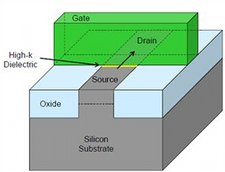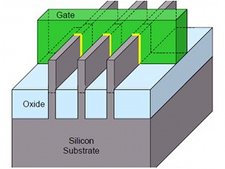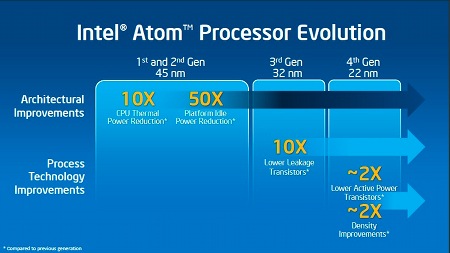3-D will indeed help Intel beat back ARM, iHS iSuppli says
May 11, 2011 — by LinuxDevices Staff — from the LinuxDevices Archive — 1 viewsIntel's new “Tri-Gate” 3-D transistors will give Intel what it needs to fight off ARM Holdings and its licensees in the PC space, predicts IHS iSuppli. The power-saving technology will also provide the chip giant “the … ammunition it needs to assault the tablet and smart phone semiconductor market,” the research firm adds.
Moore's Law — named for Intel co-founder Gordon Moore — is a forecast for the pace of silicon technology development stating that, roughly every two years, transistor density will double, decreasing costs while increasing performance. The law had been expected to start bumping up against physical limits as transistors shrink, since atoms themselves are approximately 0.5-nanometer (nm) wide.
But Intel officials on May 4 introduced the new transistor technology they called Tri-Gate, which essentially moves away from the flat "planar" circuitry of previous designs and to a three-dimensional structure. The Tri-Gate transistors will appear in Intel's upcoming "Ivy Bridge" processors, the 22nm shrink of the current "Sandy Bridge" microarchitecture.
The Tri-Gate design enables the Ivy Bridge processors to offer higher levels of performance while driving down electrical leakage and power consumption, all in a package smaller than the current 32nm chip design, according to Intel. The company has likened the idea behind the Tri-Gate design (below) to that of a skyscraper.


2D transistors (left) and 3D Tri-Gate transistors (right)
Source: Intel
(Click either to enlarge)
The numbers are impressive: 37 percent better performance than current 32-nm chips and 50 percent power reduction. Ivy Bridge chips will begin sampling later this year, and begin appearing in PCs and servers in early 2012, officials said.
But despite Tri-Gate, Intel won't be able to make much of an impact in the mobile space with its x86 processors, various analysts were quoted as saying last week. Even worse for Intel, IDC has predicated more than 13 percent of "PC processsors" will be based on ARM designs by 2015. The well-known research firm added in a May 5 release that this is the first time it has felt the need to forecast PC microprocessor units by processor architecture.

The recently announced CompuLab Trim-Slice is an ARM-based PC currently aimed at software developers
(Click for more information)
But in a May 10 statement, iHS iSuppli says Tri-Gate technology will "fight off a potential incursion into the PC business from rival ARM devices." The research firm adds that 3-D will also "allow Intel to make a renewed bid to establish a presence in the tablet and smart phone chipset market."
The concept of a 3-D structure is not new in chip manufacturing, since Taiwan Semiconductor Manufacturing Corp. (TSMC) and IBM have been developing such technology for several years, iHS iSuppli points out. However, the firm adds, Intel's Tri-Gate is ready for volume production — representing a significant technological achievement.
Len Jelinek, director and chief analyst for semiconductor manufacturing at IHS, stated, "The capability to go into high-volume production should give Intel a two- to three-year manufacturing advantage over its competitors."
Matthew Wilkins, principal analyst for compute platforms research at IHS, added, "A 50 percent reduction in power consumption is significant. The less power your electronic device consumes, the longer the battery will last, and the longer a user can be truly mobile."
iHS iSuppli further notes that Tri-Gate can be shrunk to the sub-20nm level when the next generation of lithography tools becomes available, allowing further gains in performance, power savings and cost reduction. Furthermore, it notes, the manufacturing cost of Tri-Gate technology is only about two to three percent more per device compared to conventional planar technology.
Transitioning to a 3-D transistor gives Intel the capability to manufacture a fully depleted transistor without having to use a silicon-on-insulator (SOI) structure. This eliminates the need to use special SOI wafers, which cost more than conventional wafers, iHS iSuppli says.
iHS iSuppli did not address rumors that Intel might license ARM technology itself, or that it might seek to become become Apple's foundry for ARM-based chips. But the research firm' statement seems to suggest Intel will be able to prevail on its own without taking such outré steps.
No specific plans for mobile devices were set forth at Intel's May 4 press conference, but a company release said its 3-D technology will also be used in future Atom processors and SoCs (systems on chip), resulting in devices that will require less than 1mW of idle power. The chipmaker has already promised 22nm Atoms, as indicated in the slide below.

Intel's Atoms will shrink via 22nm fabrication
(Click to enlarge)
Jonathan Angel can be followed at www.twitter.com/gadgetsense.
This article was originally published on LinuxDevices.com and has been donated to the open source community by QuinStreet Inc. Please visit LinuxToday.com for up-to-date news and articles about Linux and open source.